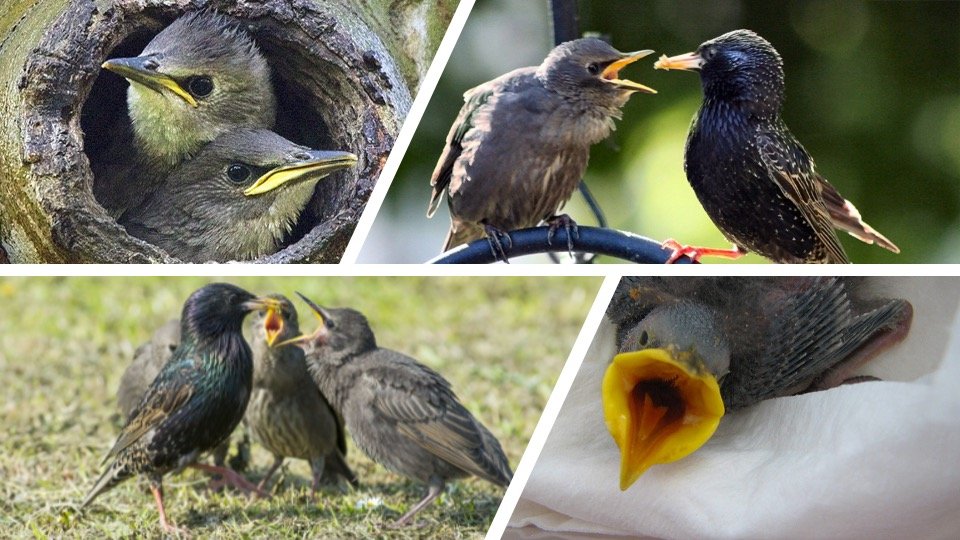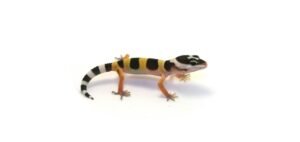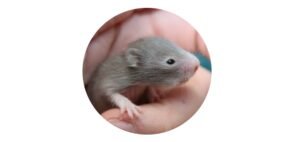Baby Starlings: All You Need To Know
Table of Contents
What does a baby starling look like?
When newly hatched, baby starlings have a single covering of white natal or light grey down beside this they are pretty much naked. baby starlings’s bill is yellow while their gape is orange. Compared to other birds these nestlings have more quantity of natal down.

Baby starling are born dependent on their parents as they are altrical meaning they hatch in an underdeveloped state. Baby starlings start to move around 2 days and by 4 days they can crawl.
Baby starling’s eyes usually do not open until the age of between six and seven days old. The contour feathers though are visible, they only emerge after the chick turns a week old. It generally takes 15-21 days for the starlings to become feathered fully.
After baby starling’s plumage develops to an extent they can regulate their body temperature, this occurs when they reach 13 days old.
Baby Starlings
The Sturnus vulgari is a common widespread European starling and found all-round year in the Europe and UK. They have been introduced in countries like United States, Australia, Canada, and New Zealand and have established their population there.
Even though they are abundant in cities and town populations not much information is available about their babies. This guide covers the most common frequent questions about young starlings.
How big is a baby starling?
Baby starling are tiny when they hatch like other birds. The culmen that is the upper ridge of the beak is 8 mm in length, while their tarsus or legs are just 9 mm in length.
How much does a baby starling weigh?
The baby starling of European starling measures just 6.4 grams only. In the first 11 to 12 days they increase their mass rapidly and about this time weigh 71 grams.
For the next week, they gain a gram a day for about 18 days and will weigh around 78 grams. This is their heaviest weight that they reach around 21-22 days after which they will start to decrease and be around 71 grams again.
What does a juvenile starling look like?
The juvenile starlings resemble adults in size and shape. They have a light greyish-brown color all along their body, their chin is lightish, while their breast is buffy white with brown tips. Their long bill is usually dark and cinnamon-colored edges are present in both tail and wing feathers.
What is a baby starling called?
There is no specific term for baby starlings, and are referred to as hatchling, chick, nestling, or fledgling. These terms are often employed by ornithologists and birdwatchers.
What do baby starlings eat?
Starling feed their hatchlings or baby starling with a mixture consisting of small soft-bodied invertebrates that are brought back by the parents. The insects in the diet may vary according to the species and usually include caterpillars, cranefly larvae, crickets beetles, millipedes, and grasshoppers.
After hatching these insects are fed to the baby starling and as they grow older they start feeding on larger insects and often a wider assortment of food is introduced.
Parents often built up a food reservoir or stock before the baby starling hatch to ensure a good supply of feed for them. Both the parents usually share the responsibilities of feeding the young.
Even after the young starlings fledge, the parents will continue to feed them for a short while and in the meanwhile will introduce them to the adult diet.
What do starling eggs look like?
Their eggs have a distinct pale blue color or they may also be white. The average egg measures 30 x 21mm with a weight of 7 grams.
Generally, their clutch size is up to 4-5 eggs and they lay up to 2 clutches per breeding season.
How long do starling eggs take to hatch?
The starling eggs hatch after a period of 12-15 days after being laid. The incubation duties are shared by both parents and they may change their duties many times even in a day.
This is due to the fact that incubation bouts can be low as 10-30 minutes before a changeover. Females usually incubate the eggs more and may even sit on eggs throughout the night.
When are starlings born?
The breeding season in their native region can start as early as March and may go till July. Whereas in northern parts or UK, it may last from April and May and is much shorter. The breeding season in North America is much later and occurs from September to December.
How do starlings feed baby starlings?
The newly hatched birds are fed on soft-shelled insects that are placed in the throats of hungry begging chicks.
The feeding process is pretty intensive as in a day there can be about 100-300 feeding visits in a day itself. They return to the nest every 14 minutes after finding food.
They are the busiest in the morning and late afternoons as the chicks feed 20 times more during this time.
When can baby starlings fly?
Around 19 days of age they start to fly and the number of days required may vary from individual to individual.
They can fly well at this stage but they may not fledge at this point. They exercise their legs and wings and practice flying before they finally venture into flight.
When do baby starlings leave the nest?
The starling chicks fledge the nest around 21 days that is about 3 weeks. They may actually depart only after one or two days from the nest.
After fledging, they utilizing their full-grown feathers can fly for reasonably long periods, but they won’t linger although most of the time, they’ll not go travel too far away from the nesting site.
For the first few days after leaving the nest, fledgling starlings are still fed by their parents. They may perch in nearby trees while they are waiting to be fed.
Where do starlings nest?
They construct their nests in cavities and holes of trees. Other frequent places include nestboxes, buildings, and old cavities. They require a cavity or hole.
After they find a suitable site, they start to look for materials like pine needles, twigs, and grass. They may also use paper, cloth, plastics, feathers, and string.
They make the cup lining using a mixture of wool, moss, feathers, fine grass, paper, and fine bark. The nests are usually 18 meters off ground, but the average height maybe 3 to 8 m.
Do starlings reuse nests?
They may not usually reuse the nests but may build new nests on top of older ones. About a third of females on average may return to their previous site and nesting location.
Starling colonies do return to the same site for breeding while their fledged young will form a new colony in a different site.
How long do baby starlings stay with their parents?
The young starling after few days of fledging will leave the nest and are usually capable of foraging but the parents may feed them for the first few days of leaving the nest. The fledging may then still depend on their parents for 10-12 days during which the quantity of feed provided by parents declines steadily so that after this they will have to fend for themselves.
Once they become independent, they will roost communally with other starlings and will start to feed in mixed groups consisting of other juveniles and adults.
Do starlings mate for life?
They are majorly monogamous but they do not mate for life. They usually raise a brood in a brooding season with a single mate and may change partners in different breeding seasons.
Some cases of polygamy have been reported, where males have multiple partners during a breeding season and may generate different broods with many females. Once the males have found their mate they will guard them for about 4 days before egg-laying.
During this time they will follow the females closely while they are foraging and may chase other males off. This behavior may end early if the male is polygamous and may attempt to attract another mate nearby.
What do you do if you find a baby starling?
If a baby starling is found, then initially it should be ascertained whether they are a fledgling or nestling. If it is a fledgling then there is not a need to intervene as they may spend some time in the ground so that their flight feathers develop properly. Their parents may be watching from nearby trees.
If there is an immediate threat to the starling then you should intervene. If the starling is a nestling then they may lack feathers or may have few feathers.
If the starling is healthy then place it back in its nest when the parents are not present. The parents as opposed to the general misconception do not reject the nestling as starlings are not known for their sense of smell.
If the nestling is injured then they should not be placed back in the nest as they may be rejected. They may be placed in a cardboard box lined with paper towels and it is best to contact the local wildlife authority.
Why can't I raise the baby starling myself?
It is not recommended to raise a starling by yourself as they require special feeding regimes and diet and maybe better if left to professionals.
Add Your Heading Text Here










